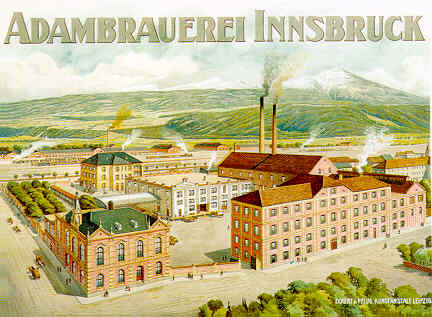 It
would be easy to assume that Austria shares a common beer culture as well
as a language with its larger neighbour. Yet in many ways Austrian beer
is distinclty different from that of Germany. The old cultural ties of the
Habsburg empire which link it with the Czech Republic are just as important.
It
would be easy to assume that Austria shares a common beer culture as well
as a language with its larger neighbour. Yet in many ways Austrian beer
is distinclty different from that of Germany. The old cultural ties of the
Habsburg empire which link it with the Czech Republic are just as important.There is one obvious and important difference between Austrian and German brewing: Austria (thankfully) does not have a Reinheitsgebot. It can be no coincidence that in Austria new breweries have been much more willing to take on a wide range of styles, including some, such as pale ale, not indigenous to central Europe. It should be noted, however, that some of the longer-established lager breweries do make a point of sticking to the Reinheitsgebot.
As is the case now in most smaller European countries, a single large company dominates the beer market. Brau-Union AG, which owns the Gösser, Zipfer, Schwechater, Wieselburger and Puntigamer breweries accounts for 56% of beer sales. It was fromed in the late 1990's by a merger of Austria's two largest brewery groups, Steirerbrau and Brau-AG.
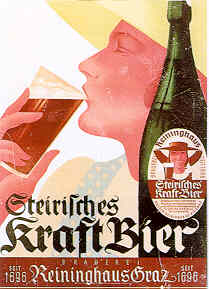 The
company appeared intent on becoming a major European player during the 1990's.
It embarked on an aggressive strategy of acquisition in countries of the
former Soviet Block, such as Poland, Romania and Hungary. I always had my
doubts about whether they really had the finances or resolve to tackle the
likes of Interbrew and Heineken head on. As it turned out, they didn't.
In 2002 the company announced that it was looking for an international partner.
In effect, they were waving a white flag and saying "please take us
over, nice Mr. Multinational". Heineken duly obliged.
The
company appeared intent on becoming a major European player during the 1990's.
It embarked on an aggressive strategy of acquisition in countries of the
former Soviet Block, such as Poland, Romania and Hungary. I always had my
doubts about whether they really had the finances or resolve to tackle the
likes of Interbrew and Heineken head on. As it turned out, they didn't.
In 2002 the company announced that it was looking for an international partner.
In effect, they were waving a white flag and saying "please take us
over, nice Mr. Multinational". Heineken duly obliged.Brau-Union still runs a large number of, by international standards, small plants in Austria. It's unlikely that the majority of them will survive long under globalist control.
All of Brau-Union's competitors brew on a much smaller scale. It is only the Brau-Union beers which are widely available on a national level. Neverthless, the top five companies account for 83% of the market between them.
There are currently 170 breweries (plus three who get their beer brewed elsewhere) operating in Austria. This is a rough breakdown of the structure of the Austrian brewing industry:
Beer Trade
Beer exports and imports just about match each other, amounting to around
5% of consumption.
When eastern European markets began to open up in the 1990's, exports
doubled, hitting a peak of 1 million hectolitres in 1994. They have now
dropped back down to the 1980's level.
Imports have been creeping up since the 1980's. The overwhelming majority
comes from just two sources, Germany (60%) and the Czech Republic (22%).
Verband der Brauereien Österreichs
The Austrian brewers' organisation.
Verband der Haus- und Kleinbrauereien Österreichs
c/o Salzburger Weißbierbrauerei
Rupertgasse 10,
5020 Salzburg.
Email: seitz@bier-kompetenz.at
http://www.kleinbrauereien.at
The organisation for small brewers. It currently has 28 members.
BierIG
Pötzelsbergstraße 5b,
5162 Obertrum.
Email: info@bierig.org
Homepage: www.bierig.org
Austrian beer consumers' organisation, a member of the EBCU.
Kampagne für gutes Bier (KGBier)
Email: info@kgbier.at
Homepage: www.kgbier.at
Another Austrian beer consumers' organisation.
Where to buy Austrian beer in the UK
Austrian Beerwww.austrianbeer.co.uk
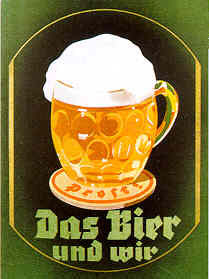
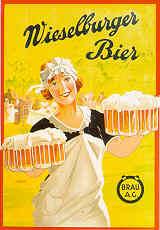 Anton
Dreher introduced bottom-fermenting beer to Austria in 1840. In 1833/34
he had travelled to Britain in the company of Gabriel Sedlmayr (of the Spaten
brewery in Munich) to study the brewing industry. On his return, he first
attempted to brew a Burton-style pale ale, though without any great success.
Inspired by what Sedlmayr had told him about the Bavarian way of brewing,
he decided to give bottom fermentation a try. The result was the first Vienna-style
amber lager.
Anton
Dreher introduced bottom-fermenting beer to Austria in 1840. In 1833/34
he had travelled to Britain in the company of Gabriel Sedlmayr (of the Spaten
brewery in Munich) to study the brewing industry. On his return, he first
attempted to brew a Burton-style pale ale, though without any great success.
Inspired by what Sedlmayr had told him about the Bavarian way of brewing,
he decided to give bottom fermentation a try. The result was the first Vienna-style
amber lager.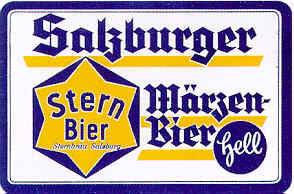 Märzen
(or Lagerbier): Not to be confused with the German style of the same
name, an Austrian Märzen is a pale lager of 11º to 12.5º
Plato and 5 - 5.2% alcohol. The densities have fallen a shade in the last
ten years, with some beers dropping below 12º.
Märzen
(or Lagerbier): Not to be confused with the German style of the same
name, an Austrian Märzen is a pale lager of 11º to 12.5º
Plato and 5 - 5.2% alcohol. The densities have fallen a shade in the last
ten years, with some beers dropping below 12º.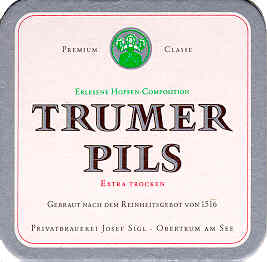 Pils:
The Austrian version is pretty much to the international standard: highly-attenuated,
very little malt character, heavily-hopped. They are 11-12 Plato and
somewhere around 5% alcohol.
Pils:
The Austrian version is pretty much to the international standard: highly-attenuated,
very little malt character, heavily-hopped. They are 11-12 Plato and
somewhere around 5% alcohol. 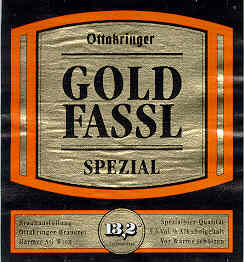 Spezialbier:
Very much like a Bavarian Spezial - a pale lager of at least 12.5º
Plato and around 5.5% alcohol, full-bodied and quite hoppy.
Spezialbier:
Very much like a Bavarian Spezial - a pale lager of at least 12.5º
Plato and around 5.5% alcohol, full-bodied and quite hoppy. 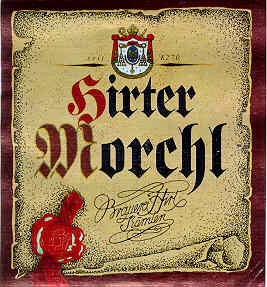 Dunkles:
This term covers quite a wide variation in flavours, which all get lumped
together as "dark" lagers. They vary in density between 12º
and 14º Plato, but because of the high concentration of residual
sugars are weaker - 4 % to 5.5% - than would be expected.
Dunkles:
This term covers quite a wide variation in flavours, which all get lumped
together as "dark" lagers. They vary in density between 12º
and 14º Plato, but because of the high concentration of residual
sugars are weaker - 4 % to 5.5% - than would be expected. 
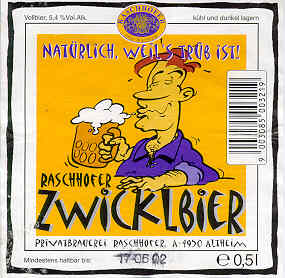 Zwicklbier:
This isn't so much a style as a method of conditioning. A zwicklbier
is any beer that is left unfiltered. Usually, it is a version of a brewery's
biggest seller - in most cases, a Märzen. Zwettl brews a Zwickl
Bock.
Zwicklbier:
This isn't so much a style as a method of conditioning. A zwicklbier
is any beer that is left unfiltered. Usually, it is a version of a brewery's
biggest seller - in most cases, a Märzen. Zwettl brews a Zwickl
Bock.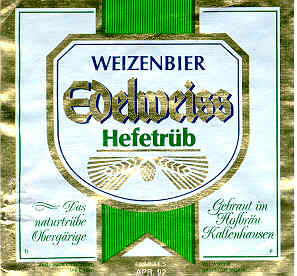 Weizenbier
Hell: A pale wheat beer with about 40% wheat in the mash. They are
between 11º and 13º Plato, 4.5% - 5.5% alcohol.
Weizenbier
Hell: A pale wheat beer with about 40% wheat in the mash. They are
between 11º and 13º Plato, 4.5% - 5.5% alcohol. 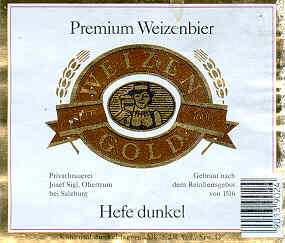 Weizenbier
Dunkel: Much the same as the pale wheat beer, except darker in colour.
They are between 11º and 13º Plato, 4.5% - 5.5% alcohol.
Weizenbier
Dunkel: Much the same as the pale wheat beer, except darker in colour.
They are between 11º and 13º Plato, 4.5% - 5.5% alcohol.  Other
styles: Some of the new small breweries produce beers in British ale
styles - porter, stout and pale ale.
Other
styles: Some of the new small breweries produce beers in British ale
styles - porter, stout and pale ale.